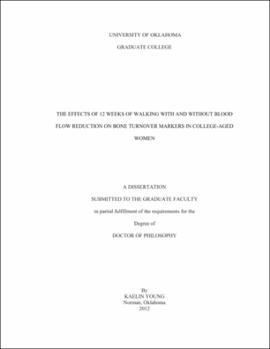| dc.description.abstract | Walking while reducing blood flow to and from the working muscles has been shown to result in strength gains and increased muscle cross-sectional area (MCSA) in young men and older adults. However, little is known about the effects of this type of novel exercise on bone metabolism and bone health. PURPOSE: To determine the effects of 12 weeks of low-intensity treadmill walking with and without blood flow restriction (BFR) on serum markers of bone metabolism in college-aged women. Secondary objectives were to examine changes in thigh and calf MCSA, muscle strength, aerobic capacity, and bone characteristics of the tibia following the intervention. METHODS: Thirty-one young women, aged 18 to 30 years, were randomly assigned to one of three groups: low-intensity treadmill walking control (WALK) (n=10), low-intensity treadmill walking with blood flow restriction (BFR) (n-11), or a non-exercise control group (CON) (n=10). Subjects in the BFR and WALK groups walked on a treadmill at a speed associated with 45% VO2peak for up to 20 minutes four days per week for 12 weeks. The BFR group wore 5 cm wide electronically monitored elastic pressure cuffs around their upper thighs during walk training. BFR cuffs were inflated to an initial pressure of 140 mmHg for the first four weeks, and then increased by 20 mmHg at week five (160 mmHg) and again at the start of week nine (180 mmHg). The CON group was asked not to change their normal physical activity levels or dietary habits over the duration of the training period. Baseline and post-testing measurements included blood sampling for the assessment of bone-specific alkaline phosphatase (Bone ALP) and tartrate-resistant acid phosphatase isoform 5b (TRAP5b); one repetition maximum (1RM) and maximal voluntary contraction (MVC) strength testing for knee extension and flexion; graded treadmill exercise test (GXT) for the determination of VO2peak; dual energy x-ray absorptiometry (DXA) to measure areal bone mineral density (aBMD) and body compsition; and peripheral Quantitative Computed Tomography (pQCT) to measure volumetric bone mineral density (vBMD) and bone area of the tibia as well as MCSA of the thigh and calf. RESULTS: A significant group x time interaction occurred for Bone ALP (p=0.02), as serum concentrations of Bone ALP were reduced in both BFR (-5.8%) and CON (-9.7%) groups post-training. Serum levels of TRAP5b and the ratio of Bone ALP to TRAP5b did not significantly change post-training. A significant group x time interaction was found for body weight (p=0.034). However, follow up analyses failed to find post-training group differences or within group changes over time (p>0.05). After analyzing percent change in body weight from baseline, significant group differences were observed between BFR (-0.8%) and WALK (2.4%) groups (p=0.046). A significant time effect (p=0.02) and group x time interaction (p=0.002) was observed for MCSA at the tibia 66% site. Follow up analyses revealed that MCSA significantly increased from baseline in both BFR (1.8%) and WALK (3.6%) groups (p<0.05). Significant time effects were found for MVC knee extension strength at joint angles of 30 degrees (p=0.02) and 60 degrees (p=0.004), with no differences between groups. A significant group x time interaction occurred for 1RM knee extension strength (p=0.014), with follow up analysis revealing a significant (p=0.026) increase in strength in the BFR group (4.5%) post-training. Significant main effects for time were found for trabecular bone content (p=0.036) and trabecular vBMD (p=0.024) at the tibia 4% site, both of which decreased over the study duration. Significant time effects were also found for total bone content (p=0.036) and SSI (p=0.011) at the tibia 38% site as well as total bone content (p=0.043), total vBMD (p=0.029), total bone area (p=0.001), periosteal circumference (p=0.002), and endosteal circumference at the 66% site. Total vBMD at the 66% site decreased post-training, whereas the other variables with significant time effects increased over the study duration. CONCLUSION: Twelve weeks of walking with BFR resulted in reduced levels of bone formation with no change in bone resorption in young women. Additionally, BFR walking resulted in favorable neuromuscular changes. | |
